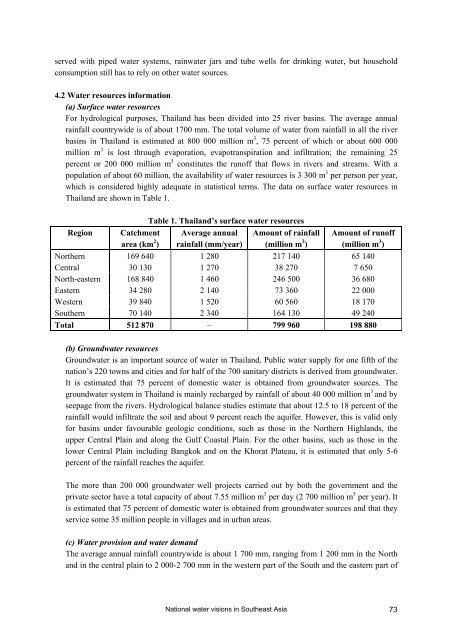The FAO-ESCAP pilot project on national water visions. From vision ...
The FAO-ESCAP pilot project on national water visions. From vision ...
The FAO-ESCAP pilot project on national water visions. From vision ...
Create successful ePaper yourself
Turn your PDF publications into a flip-book with our unique Google optimized e-Paper software.
served with piped <strong>water</strong> systems, rain<strong>water</strong> jars and tube wells for drinking <strong>water</strong>, but household<br />
c<strong>on</strong>sumpti<strong>on</strong> still has to rely <strong>on</strong> other <strong>water</strong> sources.<br />
4.2 Water resources informati<strong>on</strong><br />
(a) Surface <strong>water</strong> resources<br />
For hydrological purposes, Thailand has been divided into 25 river basins. <str<strong>on</strong>g>The</str<strong>on</strong>g> average annual<br />
rainfall countrywide is of about 1700 mm. <str<strong>on</strong>g>The</str<strong>on</strong>g> total volume of <strong>water</strong> from rainfall in all the river<br />
basins in Thailand is estimated at 800 000 milli<strong>on</strong> m 3 , 75 percent of which or about 600 000<br />
milli<strong>on</strong> m 3 is lost through evaporati<strong>on</strong>, evapotranspirati<strong>on</strong> and infiltrati<strong>on</strong>; the remaining 25<br />
percent or 200 000 milli<strong>on</strong> m 3 c<strong>on</strong>stitutes the runoff that flows in rivers and streams. With a<br />
populati<strong>on</strong> of about 60 milli<strong>on</strong>, the availability of <strong>water</strong> resources is 3 300 m 3 per pers<strong>on</strong> per year,<br />
which is c<strong>on</strong>sidered highly adequate in statistical terms. <str<strong>on</strong>g>The</str<strong>on</strong>g> data <strong>on</strong> surface <strong>water</strong> resources in<br />
Thailand are shown in Table 1.<br />
Regi<strong>on</strong><br />
Catchment<br />
area (km 2 )<br />
Table 1. Thailand’s surface <strong>water</strong> resources<br />
Average annual<br />
rainfall (mm/year)<br />
Amount of rainfall<br />
(milli<strong>on</strong> m 3 )<br />
Amount of runoff<br />
(milli<strong>on</strong> m 3 )<br />
Northern 169 640 1 280 217 140 65 140<br />
Central 30 130 1 270 38 270 7 650<br />
North-eastern 168 840 1 460 246 500 36 680<br />
Eastern 34 280 2 140 73 360 22 000<br />
Western 39 840 1 520 60 560 18 170<br />
Southern 70 140 2 340 164 130 49 240<br />
Total 512 870 – 799 960 198 880<br />
(b) Ground<strong>water</strong> resources<br />
Ground<strong>water</strong> is an important source of <strong>water</strong> in Thailand. Public <strong>water</strong> supply for <strong>on</strong>e fifth of the<br />
nati<strong>on</strong>’s 220 towns and cities and for half of the 700 sanitary districts is derived from ground<strong>water</strong>.<br />
It is estimated that 75 percent of domestic <strong>water</strong> is obtained from ground<strong>water</strong> sources. <str<strong>on</strong>g>The</str<strong>on</strong>g><br />
ground<strong>water</strong> system in Thailand is mainly recharged by rainfall of about 40 000 milli<strong>on</strong> m 3 and by<br />
seepage from the rivers. Hydrological balance studies estimate that about 12.5 to 18 percent of the<br />
rainfall would infiltrate the soil and about 9 percent reach the aquifer. However, this is valid <strong>on</strong>ly<br />
for basins under favourable geologic c<strong>on</strong>diti<strong>on</strong>s, such as those in the Northern Highlands, the<br />
upper Central Plain and al<strong>on</strong>g the Gulf Coastal Plain. For the other basins, such as those in the<br />
lower Central Plain including Bangkok and <strong>on</strong> the Khorat Plateau, it is estimated that <strong>on</strong>ly 5-6<br />
percent of the rainfall reaches the aquifer.<br />
<str<strong>on</strong>g>The</str<strong>on</strong>g> more than 200 000 ground<strong>water</strong> well <str<strong>on</strong>g>project</str<strong>on</strong>g>s carried out by both the government and the<br />
private sector have a total capacity of about 7.55 milli<strong>on</strong> m 3 per day (2 700 milli<strong>on</strong> m 3 per year). It<br />
is estimated that 75 percent of domestic <strong>water</strong> is obtained from ground<strong>water</strong> sources and that they<br />
service some 35 milli<strong>on</strong> people in villages and in urban areas.<br />
(c) Water provisi<strong>on</strong> and <strong>water</strong> demand<br />
<str<strong>on</strong>g>The</str<strong>on</strong>g> average annual rainfall countrywide is about 1 700 mm, ranging from 1 200 mm in the North<br />
and in the central plain to 2 000-2 700 mm in the western part of the South and the eastern part of<br />
Nati<strong>on</strong>al <strong>water</strong> visi<strong>on</strong>s in Southeast Asia 73
















